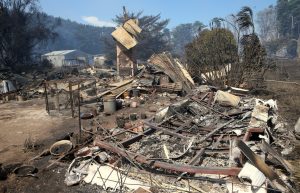
By Rod Nickel and Liz Hampton
FORT MCMURRAY/LAC LA BICHE, Alberta (Reuters) – Reconstructing Fort McMurray will be easier than first feared since much of the city’s critical infrastructure remains intact but the once booming oil town will be smaller than before, according to its mayor.
The first priority is getting new temporary housing so companies can resume shuttered oil production.
Fort McMurray Mayor Melissa Blake said the fire is a chance to “right size” the city after the energy slump left it with vacant houses and unemployed workers well before wildfires hit last week.
With 10 percent of the city burned and more than 90,000 residents evacuated, the combination of a glut of prefire homes and quick-build housing are a solution as the government and oil executives try to jump-start rebuilding.
“If I look at what the circumstance gives to us, I think it’s an opportunity to right-size the community,” Blake told Reuters. “I recognize that this horror is probably going to get some people reconsidering what their futures are, whether it’s in the region or not.”
The fire may have been the final push that some residents needed to leave the isolated northern city, but major oil producers need it back on its feet quickly to restart some 1 million barrels per day of shuttered production.
The wildfire, which has spread over 229,000 hectares (566,000 acres), is still burning, though favorable weather overnight was seen helping firefighters.
While many companies have work camps at the site of their oil sands projects around Fort McMurray, workers from across Canada and around the world moved into the city with their families when the sector was booming years ago.
If energy companies can’t house workers and their families quickly, they risk losing them permanently.
The industry will support efforts to rebuild the hospital, pipelines and electrical distribution center, Suncor Inc <SU.TO> Chief Executive Officer Steve Williams said on Tuesday after a meeting of industry and provincial officials.
“FIRST WAVE”
A recovery will be easier due to the city’s largely intact infrastructure and downtown, but people are already fighting over available housing because several major residential neighborhoods were destroyed.
“We’ve got banks, companies, restoration companies, engineering companies all looking for space now. People need to stay somewhere,” said Bill de Silva, construction manager of Liam Construction, one of the city’s biggest builders.
He said the “first wave” is already trying to secure space in hotels, condominiums and apartments undamaged by the fire, but the approval process in the still-evacuated city isn’t easy.
“We’ve got to get there as quickly as we can. We can play a big role but they have to let us in. All the government red tape doesn’t help us now,” de Silva said.
Alberta Premier Rachel Notley said officials need to finish damage assessments, set up a welcome center and transportation plan and secure food and supplies before anyone can start moving back in.
“There are hazardous materials and broken power lines. Basic services, gas, water, waste disposal, healthcare and much more needs to be re-established,” she said.
“The city was surrounded by an ocean of fire only a few days ago but Fort McMurray and the surrounding communities have been saved, and they will be rebuilt.”
The province is already speaking to temporary builders.
“They’ve been asking very general questions about what kind of temporary housing solutions we can provide (and a) rough timeline of how long it would take to be installed,” said Troy Ferguson, CEO of Redrock Group, which builds modular work camps and homes in Alberta.
Marc Roy, who was chief of staff for the U.S. Federal Emergency Management Agency in Louisiana in the aftermath of Hurricane Katrina, sees parallels between the two disasters, including the total destruction of some homes.
Longer term, Roy said, authorities need to allocate resources carefully, because some residents likely will not return.
“Are you building with the hopes that you build a field of dreams and people come to fill it, or are you using your resources as wisely as you possibly can at the moment?” he said. “You just can’t put it back exactly like it was and make that your plan. That does not work.”
One wrinkle may be home insurance policies that do no pay out in full unless homeowners rebuild.
“If a customer chooses not to repair or replace, they will receive the actual cash value of the building at the time of the loss,” said Intact Insurance, Canada’s largest property and casualty insurer, in a statement. Because of the oil downturn, that cash value could be less than owners hope.
Debra Bunston, an Alberta realtor, said the disaster may fill vacant homes or spur sales of homes that are already on the market, “a bit of a silver lining in this horrible cloud of smoke.”
(Additional reporting by Allison Martell and Andrea Hopkins in Toronto and Allison Lampert in Montreal; Editing by Jeffrey Benkoe)










